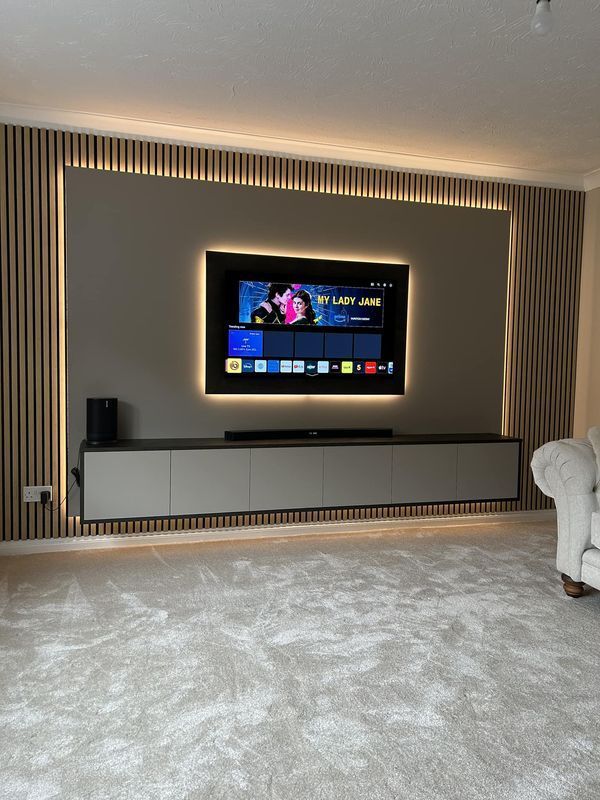A tv cabinet design is often a central piece of furniture in any living space, serving both a functional purpose for media equipment and a decorative role in defining the room’s aesthetic. While high-end, custom-built units can be stunning, they often come with a hefty price tag. The good news is that you don’t need a massive budget to achieve a stylish and functional TV setup. With a little creativity, smart shopping, and some DIY spirit, you can find or create a TV cabinet that looks fantastic without breaking the bank.
1. Repurpose and Upcycle Existing Furniture
One of the most cost-effective ways to get a “new” TV cabinet is to look at what you already have or what you can find second-hand.
- Dressers and Sideboards: An old dresser or sideboard can be easily repurposed into a TV cabinet. Their existing drawers offer ample storage for media accessories, remotes, and even DVDs. A fresh coat of paint, new hardware, or even a decorative top can completely transform its look.
- Bookcases and Shelving Units: Simple bookcases, especially those with adjustable shelves, can be adapted. Remove a few shelves to create a space for the TV, and use the remaining shelves for display or storage. You can add baskets to conceal clutter.
- Vintage Finds: Thrift stores, flea markets, and online marketplaces are treasure troves for unique, affordable furniture. Look for sturdy pieces with good bones that might just need a little TLC to become your perfect TV cabinet.
2. Embrace Modular and Ready-Made Solutions
Many retailers offer modular furniture lines that are designed to be versatile and often budget-friendly.
- IKEA Hacks: IKEA’s Besta, Kallax, and Lack series are famous for their hackability. With a few simple additions like new legs, custom doors, contact paper, or even fluted panels, you can transform these affordable units into high-end looking pieces. These systems also offer excellent built-in cable management solutions.
- Affordable Retailers: Explore budget-friendly furniture stores or online retailers that specialize in flat-pack or ready-to-assemble furniture. Look for simple, clean designs in materials like engineered wood (MDF or particle board) with laminate finishes, which are often much cheaper than solid wood.
3. DIY with Inexpensive Materials
If you’re handy, building your own TV cabinet from scratch or simple components can be incredibly rewarding and cost-effective.
- Crate or Pallet Stacks: Wooden crates or reclaimed pallets can be stacked and secured to create a rustic or industrial-style TV stand. They offer open storage and can be painted, stained, or left natural.
- Cinder Block and Wood Planks: For a truly minimalist and industrial look, stack cinder blocks and top them with sturdy wooden planks. This is incredibly cheap and can be surprisingly stylish when done thoughtfully.
- Floating Shelves: For a sleek, modern, and space-saving solution, install a few sturdy floating shelves. The TV can be wall-mounted above them, and the shelves can hold media devices and a few decorative items. This minimizes material cost and maximizes open space.
4. Smart Styling and Accessories
Even the most basic TV cabinet can look expensive with the right styling.
- Declutter: The first step to making any TV area look good is to manage cables and minimize clutter. Use cable ties, cable management boxes, and baskets to keep wires and unsightly items out of sight.
- Curated Decor: Place a few carefully chosen decorative items on or around your TV cabinet. Think small plants, books, framed photos, or a unique sculpture. Less is often more when on a budget.
- Lighting: Add a small table lamp or LED strip lighting behind the TV or within open shelves to create ambiance and draw attention to the area.
- Wallpaper or Paint Accent: If your TV is wall-mounted, consider adding a feature wall behind it with an affordable peel-and-stick wallpaper or a bold paint color. This creates a focal point without needing an elaborate cabinet.
5. Prioritize Functionality and Simplicity
When working with a budget, focus on the core function of the TV cabinet and keep the design simple.
- Size Matters: The smaller the unit, generally the less it will cost. Choose a size that is appropriate for your TV and the room, avoiding overly large or complex designs.
- Open vs. Closed Storage: Open shelves are typically cheaper than drawers or cabinets with doors, as they require less material and hardware. A mix of both can provide visual interest while keeping costs down.
- Materials: Opt for materials like MDF, particle board, or laminate finishes over solid wood or glass, which tend to be more expensive. These materials are durable enough for TV units, especially in areas not exposed to moisture.
By combining these strategies, you can achieve a TV cabinet setup that is both practical and aesthetically pleasing, proving that great design doesn’t always have to come with a high price tag.


